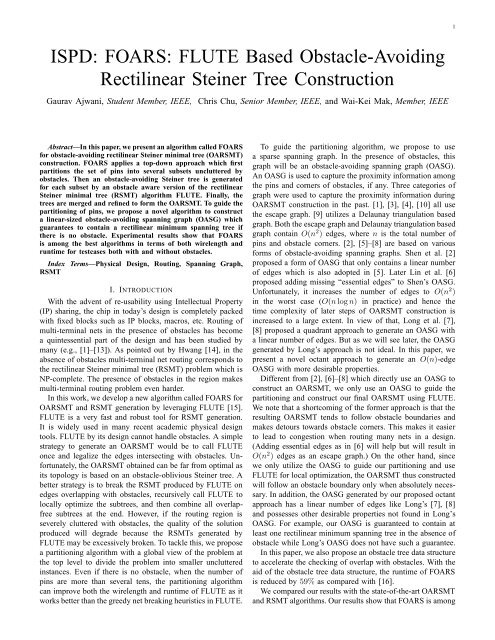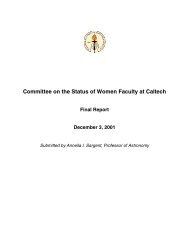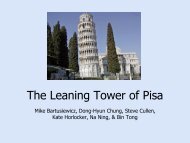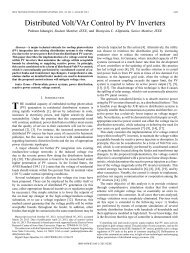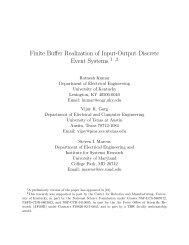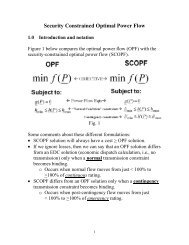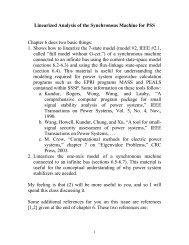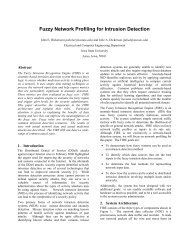FLUTE Based Obstacle-Avoiding Rectilinear Steiner Tree Construction
FLUTE Based Obstacle-Avoiding Rectilinear Steiner Tree Construction
FLUTE Based Obstacle-Avoiding Rectilinear Steiner Tree Construction
You also want an ePaper? Increase the reach of your titles
YUMPU automatically turns print PDFs into web optimized ePapers that Google loves.
1<br />
ISPD: FOARS: <strong>FLUTE</strong> <strong>Based</strong> <strong>Obstacle</strong>-<strong>Avoiding</strong><br />
<strong>Rectilinear</strong> <strong>Steiner</strong> <strong>Tree</strong> <strong>Construction</strong><br />
Gaurav Ajwani, Student Member, IEEE, Chris Chu, Senior Member, IEEE, and Wai-Kei Mak, Member, IEEE<br />
Abstract—In this paper, we present an algorithm called FOARS<br />
for obstacle-avoiding rectilinear <strong>Steiner</strong> minimal tree (OARSMT)<br />
construction. FOARS applies a top-down approach which first<br />
partitions the set of pins into several subsets uncluttered by<br />
obstacles. Then an obstacle-avoiding <strong>Steiner</strong> tree is generated<br />
for each subset by an obstacle aware version of the rectilinear<br />
<strong>Steiner</strong> minimal tree (RSMT) algorithm <strong>FLUTE</strong>. Finally, the<br />
trees are merged and refined to form the OARSMT. To guide the<br />
partitioning of pins, we propose a novel algorithm to construct<br />
a linear-sized obstacle-avoiding spanning graph (OASG) which<br />
guarantees to contain a rectilinear minimum spanning tree if<br />
there is no obstacle. Experimental results show that FOARS<br />
is among the best algorithms in terms of both wirelength and<br />
runtime for testcases both with and without obstacles.<br />
Index Terms—Physical Design, Routing, Spanning Graph,<br />
RSMT<br />
I. INTRODUCTION<br />
With the advent of re-usability using Intellectual Property<br />
(IP) sharing, the chip in today’s design is completely packed<br />
with fixed blocks such as IP blocks, macros, etc. Routing of<br />
multi-terminal nets in the presence of obstacles has become<br />
a quintessential part of the design and has been studied by<br />
many (e.g., [1]–[13]). As pointed out by Hwang [14], in the<br />
absence of obstacles multi-terminal net routing corresponds to<br />
the rectilinear <strong>Steiner</strong> minimal tree (RSMT) problem which is<br />
NP-complete. The presence of obstacles in the region makes<br />
multi-terminal routing problem even harder.<br />
In this work, we develop a new algorithm called FOARS for<br />
OARSMT and RSMT generation by leveraging <strong>FLUTE</strong> [15].<br />
<strong>FLUTE</strong> is a very fast and robust tool for RSMT generation.<br />
It is widely used in many recent academic physical design<br />
tools. <strong>FLUTE</strong> by its design cannot handle obstacles. A simple<br />
strategy to generate an OARSMT would be to call <strong>FLUTE</strong><br />
once and legalize the edges intersecting with obstacles. Unfortunately,<br />
the OARSMT obtained can be far from optimal as<br />
its topology is based on an obstacle-oblivious <strong>Steiner</strong> tree. A<br />
better strategy is to break the RSMT produced by <strong>FLUTE</strong> on<br />
edges overlapping with obstacles, recursively call <strong>FLUTE</strong> to<br />
locally optimize the subtrees, and then combine all overlapfree<br />
subtrees at the end. However, if the routing region is<br />
severely cluttered with obstacles, the quality of the solution<br />
produced will degrade because the RSMTs generated by<br />
<strong>FLUTE</strong> may be excessively broken. To tackle this, we propose<br />
a partitioning algorithm with a global view of the problem at<br />
the top level to divide the problem into smaller uncluttered<br />
instances. Even if there is no obstacle, when the number of<br />
pins are more than several tens, the partitioning algorithm<br />
can improve both the wirelength and runtime of <strong>FLUTE</strong> as it<br />
works better than the greedy net breaking heuristics in <strong>FLUTE</strong>.<br />
To guide the partitioning algorithm, we propose to use<br />
a sparse spanning graph. In the presence of obstacles, this<br />
graph will be an obstacle-avoiding spanning graph (OASG).<br />
An OASG is used to capture the proximity information among<br />
the pins and corners of obstacles, if any. Three categories of<br />
graph were used to capture the proximity information during<br />
OARSMT construction in the past. [1], [3], [4], [10] all use<br />
the escape graph. [9] utilizes a Delaunay triangulation based<br />
graph. Both the escape graph and Delaunay triangulation based<br />
graph contain O(n 2 ) edges, where n is the total number of<br />
pins and obstacle corners. [2], [5]–[8] are based on various<br />
forms of obstacle-avoiding spanning graphs. Shen et al. [2]<br />
proposed a form of OASG that only contains a linear number<br />
of edges which is also adopted in [5]. Later Lin et al. [6]<br />
proposed adding missing “essential edges” to Shen’s OASG.<br />
Unfortunately, it increases the number of edges to O(n 2 )<br />
in the worst case (O(n log n) in practice) and hence the<br />
time complexity of later steps of OARSMT construction is<br />
increased to a large extent. In view of that, Long et al. [7],<br />
[8] proposed a quadrant approach to generate an OASG with<br />
a linear number of edges. But as we will see later, the OASG<br />
generated by Long’s approach is not ideal. In this paper, we<br />
present a novel octant approach to generate an O(n)-edge<br />
OASG with more desirable properties.<br />
Different from [2], [6]–[8] which directly use an OASG to<br />
construct an OARSMT, we only use an OASG to guide the<br />
partitioning and construct our final OARSMT using <strong>FLUTE</strong>.<br />
We note that a shortcoming of the former approach is that the<br />
resulting OARSMT tends to follow obstacle boundaries and<br />
makes detours towards obstacle corners. This makes it easier<br />
to lead to congestion when routing many nets in a design.<br />
(Adding essential edges as in [6] will help but will result in<br />
O(n 2 ) edges as an escape graph.) On the other hand, since<br />
we only utilize the OASG to guide our partitioning and use<br />
<strong>FLUTE</strong> for local optimization, the OARSMT thus constructed<br />
will follow an obstacle boundary only when absolutely necessary.<br />
In addition, the OASG generated by our proposed octant<br />
approach has a linear number of edges like Long’s [7], [8]<br />
and possesses other desirable properties not found in Long’s<br />
OASG. For example, our OASG is guaranteed to contain at<br />
least one rectilinear minimum spanning tree in the absence of<br />
obstacle while Long’s OASG does not have such a guarantee.<br />
In this paper, we also propose an obstacle tree data structure<br />
to accelerate the checking of overlap with obstacles. With the<br />
aid of the obstacle tree data structure, the runtime of FOARS<br />
is reduced by 59% as compared with [16].<br />
We compared our results with the state-of-the-art OARSMT<br />
and RSMT algorithms. Our results show that FOARS is among
9000<br />
8000<br />
7000<br />
6000<br />
5000<br />
4000<br />
3000<br />
2000<br />
1000<br />
9000<br />
8000<br />
7000<br />
6000<br />
5000<br />
4000<br />
3000<br />
2000<br />
1000<br />
9000<br />
8000<br />
7000<br />
6000<br />
5000<br />
4000<br />
3000<br />
2000<br />
1000<br />
9000<br />
8000<br />
7000<br />
6000<br />
5000<br />
4000<br />
3000<br />
2000<br />
1000<br />
2<br />
the best in terms of both wirelength and runtime for testcases<br />
both with and without obstacles and especially for large<br />
testcases.<br />
The rest of the paper is organized as follows. We first<br />
provide an overview of the main steps of our OARSMT construction<br />
approach in Section 2. Each main step is described in<br />
details in Sections 3 to 7. The experimental results are reported<br />
in Section 8. Finally, we give our conclusion in Section 9.<br />
II. OVERVIEW OF FOARS<br />
Our algorithm can be distinctly divided into the following<br />
five stages.<br />
Stage 1: OASG Generation. First, we obtain the connectivity<br />
information between the pins and obstacle corner vertices<br />
using a novel octant OASG generation algorithm. Section 3<br />
describes the OASG algorithm in detail.<br />
Stage 2: OPMST Generation <strong>Based</strong> on the OASG, we<br />
construct a minimum terminal spanning tree (MTST) using<br />
the approach mentioned in [17] and then obtain an obstacle<br />
penalized minimal spanning tree (OPMST) from the MTST.<br />
Section 4 talks about OPMST construction in detail.<br />
Stage 3: OAST Generation. We partition the pin vertices<br />
based on the OPMST constructed in the previous step. After<br />
partitioning, we pass the subproblems to OA-<strong>FLUTE</strong> which<br />
calls <strong>FLUTE</strong> recursively to construct an obstacle-aware <strong>Steiner</strong><br />
tree (OAST). Section 5 talks about the partitioning and OA-<br />
<strong>FLUTE</strong> in more detail.<br />
Stage 4: OARSMT Generation. In this step, we rectilinearize<br />
the pin-to-pin connections avoiding obstacles to<br />
construct an OARSMT. Section 6 discusses OARSMT construction.<br />
Stage 5: Refinement. To further reduce the wirelength, we<br />
perform V-shape refinement on the OARSMT. Details for it<br />
can be found in Section 7.<br />
Fig. 1 depicts the outputs after various stages of the<br />
algorithm.<br />
A. Previous Approaches<br />
III. OASG GENERATION<br />
We first define what we meant by an obstacle-avoiding<br />
spanning graph.<br />
Definition 1 Given an edge e(u, v) and an obstacle b,<br />
e is completely blocked by b if every monotonic Manhattan<br />
path connecting u and v intersects with a boundary of b.<br />
Definition 2 Given a set of m pins and k obstacles, an<br />
undirected graph G = (V, E) connecting all pin and corner<br />
vertices is called an OASG if none of its edges is completely<br />
blocked by an obstacle.<br />
Although Definition 2 does not necessitate a linear number<br />
of edges for an OASG, in order to have a fast runtime<br />
it is desired to limit the solution space. In the past, there<br />
have been a couple of efforts to construct an OASG with a<br />
linear number of edges. Shen et al. [2] suggested a quadrant<br />
approach in which each point can connect in four quadrants<br />
in the plane formed by horizontal and vertical line going<br />
through the point. Shen did not clearly explain their algorithm<br />
in the paper.<br />
Long et al. [7] recently described an O(n log n)-time approach<br />
for OASG generation with a linear number of edges<br />
by considering quadrant partition of the plane. They suggested<br />
scanning along ±45 ◦ lines and maintaining an active vertex<br />
list, a set of vertices in the graph which are not yet connected<br />
to their nearest neighbor. After scanning any vertex v, they<br />
search for its nearest neighbor u in the active vertex list, such<br />
that the edge (u, v) is not completely blocked by any obstacle<br />
in the graph. This is followed by deletion of u from the list<br />
and addition of v in the list.<br />
We found that the OASG generation algorithm in [7] has a<br />
few shortcomings. First in their algorithm, the nearest neighbor<br />
for any vertex in a quadrant is contingent upon the direction<br />
of scanning which means they have to scan along all four<br />
quadrants of a vertex in order to capture its connectivity<br />
information. Second, in the absence of obstacles, their algorithm<br />
cannot guarantee the presence of at least one minimum<br />
spanning tree in their spanning graph. Third, their algorithm<br />
cannot handle abutting obstacles due to minor mistakes in the<br />
inequality conditions.<br />
0<br />
0 1000 2000 3000 4000 5000 6000 7000 8000 9000 10000<br />
(a) OASG<br />
0<br />
0 1000 2000 3000 4000 5000 6000 7000 8000 9000 10000<br />
0<br />
0 1000 2000 3000 4000 5000 6000 7000 8000 9000 10000<br />
(b) MTST<br />
0<br />
0 1000 2000 3000 4000 5000 6000 7000 8000 9000 10000<br />
B. Our Approach for OASG<br />
In [18], Zhou et al. proposed an elegant algorithm to<br />
generate a spanning graph with a linear number of edges<br />
guaranteed to contain a minimum rectilinear spanning tree<br />
on an obstacle-free plane by considering octant partition of<br />
the plane. So, we also propose an OASG algorithm based<br />
on octant partition. Fig. 2(a) and Fig. 2(b) describe octant<br />
partition for a pin vertex and an obstacle corner, respectively.<br />
Fig. 1.<br />
RC01<br />
(c) OPMST<br />
(d) OARSMT<br />
Demonstration of the major steps of FOARS using the benchmark<br />
A property of octant partition is that a contour of equidistant<br />
points from any point forms a line segment in each region.<br />
In regions R 1 ,R 2 ,R 5 ,R 6 , these segments are captured by an<br />
equation of the form x+y = c for some constant c; in regions
3<br />
Fig. 2.<br />
(a) Pin vertex<br />
(b) <strong>Obstacle</strong> corner<br />
Octant partition for a pin vertex and an obstacle corner<br />
R 3 ,R 4 ,R 7 ,R 8 , they are described by the equation x − y = c<br />
for some constant c. Now this property can be exploited when<br />
we generate an obstacle-avoiding spanning graph.<br />
The pseudocode for OASG generation for R 1 is provided in<br />
Fig. 3. As R 1 and R 2 both follow the same sweep sequence we<br />
process them together in one pass. It is worth noting that it is<br />
sufficient to sweep for R 1 , R 2 , R 3 and R 4 only. For any point,<br />
we only need to sweep twice to determine its connectivity<br />
information once for R 1 /R 2 and once for R 3 /R 4 .<br />
point we delete all the points in S(v) from A active (line 8)<br />
and add v to A active (line 18).<br />
In order to determine if an edge is blocked by an obstacle,<br />
we maintain two active obstacle boundary lists, A bottom for<br />
the bottom boundaries and A left for the left boundaries. It is<br />
evident that if an edge is blocked by an obstacle in R 1 , it will<br />
intersect with either its bottom or its left boundary. Next, if<br />
our scanned vertex is the bottom left corner of an obstacle,<br />
its bottom boundary is added to A bottom and its left boundary<br />
is added to A left . It implies that both the left and the bottom<br />
boundaries of that obstacle become active. When we come<br />
across the top left (bottom right) corner, the corresponding<br />
boundary is removed from A left (A bottom ) implying that the<br />
left (bottom) boundary for that obstacle becomes inactive at<br />
that point (lines 12 and 15).<br />
To explain lines 13 to 17, let us refer to Fig. 4 where vertex<br />
b is the bottom right corner of an obstacle. It is easy to see<br />
that if any vertex u lying within the 45 − 45 − 90 triangle<br />
shown is still in A active after scanning b, it can be removed<br />
from A active . Since in this case all vertices in R 1 of u are<br />
completely blocked from u by the obstacle.<br />
Algorithm: OASG Generation for R 1<br />
Fig. 3.<br />
1 A active = A bottom = A left = ∅<br />
2 for all v ∈ V in increasing (x + y) order do<br />
3 S(v) = ∅<br />
4 for all u ∈ A active which have v in their R 1 do<br />
5 Add u to S(v)<br />
6 end for<br />
7 Connect v to the nearest point u ∗ ∈ S(v) such that<br />
e(u ∗ , v) is not completely blocked<br />
by obstacle boundaries in A bottom and A left<br />
8 Delete all points in S(v) from A active<br />
9 if v is a bottom left corner then<br />
10 Add the bottom boundary containing v to A bottom<br />
and the left boundary containing v to A left<br />
11 else if v is a top left corner then<br />
12 Delete the left boundary containing v from A left<br />
13 else if v is a bottom right corner then<br />
14 Determine the bottom boundary B containing v<br />
15 Delete B from A bottom<br />
16 Delete from A active all points which are<br />
completely blocked by B<br />
17 end if<br />
18 Add v to A active<br />
19 end for<br />
Pseudocode for OASG generation algorithm<br />
For octants R 1 and R 2 , we sweep on a list of vertices in<br />
V which contains both pins as well as obstacle corners with<br />
respect to increasing (x+y). During sweeping we maintain an<br />
active vertex list A active . An active vertex is a vertex whose<br />
nearest neighbor in R 1 still needs to be discovered.<br />
For the currently scanned vertex v, while looking in R 5<br />
of v we extract a subset S(v) from A active . Any node u in<br />
this subset S(v) has v in R 1 (lines 3 to 6). We connect v<br />
to its nearest neighbor u ∗ in S(v) for which, e(u ∗ , v) is not<br />
completely blocked (line 7). After connecting with the nearest<br />
Fig. 4. Any vertex within the lightly shaded triangle is completely blocked<br />
by boundary (a,b).<br />
We have the following lemma that relates our obstacleavoiding<br />
spanning graph generation algorithm to the<br />
obstacle-free spanning graph generation algorithm in [18].<br />
Lemma 1 The algorithm of Zhou et al. [18] is a special case<br />
of our OASG generation algorithm<br />
Proof: If we consider an instance which has no obstacle, then<br />
we can simply ignore the blockage check in line 7 and lines<br />
9 to 17 from the algorithm in Fig. 3. The resulting algorithm<br />
would be exactly the same as the spanning graph generation<br />
algorithm in [18].<br />
□<br />
Corollary 1 In the absence of obstacle, our OASG generation<br />
algorithm generates a spanning graph that contains at least<br />
one minimum rectilinear spanning tree of the given pins.<br />
Proof: By Lemma 1, our OASG algorithm generates<br />
the same result as the obstacle-free spanning graph generation<br />
algorithm in [18] when there is no obstacle. Moreover, it has<br />
been proved in [18] that the obstacle-free spanning graph<br />
generated is guaranteed to contain at least one minimum
4<br />
spanning tree of the given pins.<br />
C. An Efficient Implementation<br />
In this section we show how to efficiently perform the<br />
following fundamental operations in the OASG generation<br />
algorithm: 1) Given a vertex v, find the subset of points in<br />
A active which have v in their R 1 ; 2) given an edge, check if<br />
it is completely blocked by any obstacle boundary in A bottom<br />
or A left ; and 3) given a bottom boundary of an obstacle,<br />
find all points in A active which are completely blocked by the<br />
boundary. We address these issues one by one in the following<br />
paragraphs.<br />
To find the subset of points in A active that have a given<br />
point in their R 1 , we first state and prove two lemmas and a<br />
corollary for our OASG generation algorithm. Similar ideas<br />
have been outlined in [18].<br />
Lemma 2 Point v is in the R 1 region of point p if<br />
and only if x p ≤ x v and x p − y p ≥ x v − y v .<br />
Proof: By definition, the R 1 region of p is the region<br />
to the right of the vertical line passing through p and above<br />
the line with slope = 1 passing through p (see Fig. 2). In other<br />
words, point v is in the R 1 region of p if and only if x p ≤ x v<br />
and yv−yp<br />
x v−x p<br />
≥ 1. Rearranging the terms, the necessary and<br />
sufficient condition is x p ≤ x v and x p − y p ≥ x v − y v . □<br />
Lemma 3 At any time, no point in the active set can<br />
be in the R 1 region of another point in the set.<br />
Proof: Before we add a new point v to the active set<br />
(line 18), we would delete all points in the active set that<br />
have v in their R 1 regions (line 8). In addition, any point<br />
already in the active set cannot be in the R 1 region of point<br />
v as we are processing in increasing (x + y) order. Hence,<br />
no point in the active set can be in the R 1 region of another<br />
point in the set at any time.<br />
□<br />
Corollary 2 For any two points p and q in the active<br />
set, we have x p ≠ x q , and if x p < x q then x p −y p ≤ x q −y q .<br />
Proof: Assume points p and q are in the active set.<br />
Then we cannot have x p = x q , otherwise p would be<br />
in the R 1 region of q or vice versa by Lemma 2 which<br />
contradicts Lemma 3. And we cannot have x p < x q and<br />
x p − y p ≥ x q − y q , otherwise q would be in the R 1 region of<br />
p by Lemma 2 which again contradicts Lemma 3. Hence, the<br />
corollary is proved.<br />
□<br />
To facilitate finding the points in A active that have a<br />
given point in their R 1 regions, we keep the points in A active<br />
in increasing order of their x-coordinate. To find the subset<br />
of points which have v in their R 1 , we first find the largest<br />
x in A active such that x ≤ x v . We then scan A active in<br />
decreasing order of x until x − y < x v − y v . Note that by<br />
Corollary 2, decreasing order of x automatically implies<br />
non-increasing order of x − y. Any point in between has<br />
□<br />
x ≤ x v and x − y ≥ x v − y v , and hence has v in its R 1 by<br />
Lemma 2. We use a balanced binary search tree to implement<br />
A active in order to have O(log n) query operation to find the<br />
largest x in A active such that x ≤ x v .<br />
An edge e(u, v) formed by points (x u , y u ) and (x v , y v )<br />
is completely blocked by a bottom obstacle boundary (a, b)<br />
formed by the points (x a , y h ) and (x b , y h ), if and only if,<br />
y u < y h < y v , x a < x u , and x b > x v . Note that at line 7,<br />
all bottom boundaries satisfying the condition must be present<br />
in the list A bottom . We use a balanced binary search tree data<br />
structure for A bottom with the y-coordinate of a boundary as<br />
a key value. If there are k bottom boundaries between y u and<br />
y v , it takes takes O(log n + k) time to check if any of them<br />
blocks edge e. Checking if an edge is completely blocked by<br />
a left boundary can be done similarly.<br />
To determine all the completely blocked vertices u in<br />
A active by a horizontal boundary (a, b) in line 16, we need to<br />
check if y u < y h , x a < x u and x u −y u +y h ≤ x b (the lightly<br />
shaded region in Fig. 4). Since we already have A active as a<br />
sorted list in increasing x we can check all points which lie<br />
between x a and x b and test for the above conditions to see if<br />
they are completely blocked.<br />
In [16] we made a claim about runtime complexity of<br />
the overall algorithm being O(n log n). It has been recently<br />
brought to our attention that there may exists extreme cases<br />
for which the total time spent by line 7 over all iterations is<br />
O(n 2 ). We concede with the argument but our algorithm is<br />
extremely fast for all practical purposes as indicated by our<br />
experimental results and it results in an OASG with a linear<br />
number of edges which limits the solution space resulting in<br />
better runtime complexity for subsequent stages.<br />
A. MTST Generation<br />
IV. OPMST GENERATION<br />
After capturing the initial connectivity among pin vertices,<br />
the next logical step is to extract a minimum terminal spanning<br />
tree (MTST) from the OASG that connects all pin vertices<br />
and avoid obstacles. Shen et al. [2] and Lin et al. [6] both<br />
use an indirect approach for this step. They first construct a<br />
complete graph over all pin vertices where the edge weight is<br />
the shortest path length between the two pin vertices. On this<br />
complete graph they use either Prim’s or Kruskal’s algorithm<br />
to obtain a MST. Although it is effective, the approach<br />
described above seems to be an overkill as it is unnecessary<br />
to construct a complete graph when we already have OASG.<br />
Back in the 80’s, Wu et al. [17] suggested a method using<br />
Dijkstra’s and Kruskal’s algorithms on a graph similar to an<br />
OASG to obtain a MTST. Recently, Long et al. [8] adopted<br />
their approach to solve the problem on the OASG.<br />
In this paper, we adopt the approach based on the extended<br />
Dijkstra’s algorithm and the extended Kruskal’s algorithm as<br />
defined in [8]. For every corner vertex in the OASG, we want<br />
to connect it with the nearest pin vertex. This can be easily<br />
done using Dijkstra’s shortest path algorithm considering<br />
every pin vertex as a source. After running the extended<br />
Dijkstra’s algorithm we are left with a forest of m terminal<br />
trees, m being the number of pin vertices. The root of every
5<br />
terminal tree in the forest obtained above is a pin vertex.<br />
In order to connect all disjoint trees we use the extended<br />
Kruskal’s algorithm on the forest. A priority queue Q is used<br />
to store the weights of all possible edges termed as bridge<br />
edges in [8] which can be used for linking the trees.<br />
Definition 4 [8] An edge e(u, v) is called a bridge<br />
edge if its two end vertices belong to different terminal trees.<br />
From Definition 4, it can be deduced that if each tree<br />
was a single vertex in the graph then bridge edges will be<br />
the edges connecting these vertices and we can use Kruskal’s<br />
algorithm to obtain a MST in such a graph. The extended<br />
Kruskal’s algorithm is simply an extended version of the<br />
original Kruskal’s algorithm tailored to obtain a MST in a<br />
forest. It is important to note that in case we do not have any<br />
obstacle, the extended Dijkstra’s algorithm will not make any<br />
change in the graph and the extended Kruskal will simply<br />
work on a spanning graph.<br />
B. OPMST <strong>Construction</strong><br />
We note that a sparse OASG does not always have direct<br />
connections between the pin vertices even if one is allowed.<br />
This is due to a neighboring corner vertex being nearer than<br />
the other pin vertex in the same region. These indirect detour<br />
paths are unnecessary and if not taken care of can lead to a<br />
significant loss of quality. We note that the algorithm proposed<br />
by [8] failed to address this issue. On the other hand, we<br />
address this problem by constructing an obstacle penalized<br />
minimal spanning tree (OPMST) from the MTST by removing<br />
all the corner vertices and storing detour information as the<br />
weight of an edge.<br />
To construct an OPMST, we follow a simple strategy. For<br />
any corner vertex v, we find the nearest neighboring pin vertex<br />
u. We connect all the pin vertices originally connected with<br />
v to u and delete v. We update their weights as their original<br />
weight plus the weight of e(u, v). This method guarantees<br />
that in case we have a major detour between two pin vertices<br />
due to an obstacle, the weight of that edge will corroborate<br />
this fact. In other words we can say that the edge would be<br />
penalized for the obstacles in its path.<br />
V. OAST GENERATION<br />
This step differentiates our algorithm from [2], [6]–[8]. We<br />
exploit the extremely fast and efficient <strong>Steiner</strong> tree generation<br />
capability of <strong>FLUTE</strong> [15] for low degree nets. In order to<br />
embed <strong>FLUTE</strong> in our problem, we designed an obstacle<br />
aware version of <strong>FLUTE</strong>, OA-<strong>FLUTE</strong>. As OA-<strong>FLUTE</strong> is less<br />
effective for high degree nets and dense obstacle region, we<br />
partition a high degree net into subnets guided by the OPMST<br />
obtained from the previous step. The subproblems obtained<br />
after partitioning are passed on to OA-<strong>FLUTE</strong> for obstacle<br />
aware topology generation. It is termed as obstacle-aware<br />
because the nodes of the tree are placed in their appropriate<br />
locations considering obstacles around them.<br />
Fig. 5 and Fig. 8 describe the pseudocodes for the Partition<br />
and OA-<strong>FLUTE</strong> functions. It is evident that both functions are<br />
recursive functions. Let us first explain the Partition function.<br />
A. Partition<br />
Function: Partition(T )<br />
Input: An OPMST T<br />
Output: An OAST<br />
1 if (∃ a completely blocked edge e) then<br />
2 /∗ Refer to Fig. 6 ∗/<br />
3 e(u, v) is to be routed around obstacle edge e(a, b)<br />
4 Let T = T 1 + e(u, v) + T 2<br />
5 T 1 = T 1 + e(u, a)<br />
6 T 2 = T 2 + e(u, b)<br />
7 T ′ = Partition(T 1) ∪ Partition(T 2)<br />
8 else if (|T | > HIGH THRESHOLD) then<br />
10 /∗ Refer to Fig. 7(a) ∗/<br />
11 Let e(u, v) be the longest edge s.t.<br />
T = T 1 + e(u, v) + T 2 with |T 1| ≥ 2 and |T 2| ≥ 2<br />
12 T ′ = Partition(T 1) ∪ Partition(T 2)<br />
13 /∗ Refer to Fig. 7(b) ∗/<br />
14 Refine T ′ using OA-<strong>FLUTE</strong>(N”)<br />
15 where N” is a set of pin vertices around e(u, v) in T ′<br />
16 else<br />
17 T ′ = OA-<strong>FLUTE</strong>(N)<br />
18 where N is set of all vertices in T<br />
19 end if<br />
20 return T ′<br />
Fig. 5.<br />
Pseudocode for the Partition function<br />
The input to the Partition function is an OPMST obtained<br />
from the last step and the output is an obstacle-aware <strong>Steiner</strong><br />
tree (OAST). An OAST is a <strong>Steiner</strong> tree in which the <strong>Steiner</strong><br />
nodes have been placed considering the obstacles present in<br />
the routing region to minimize the overall wirelength. The<br />
following two criteria are set for partitioning pin vertices. The<br />
first criterion is to determine if any edge is completely blocked<br />
by an obstacle. The second criterion is to check if the size of<br />
OPMST is more than the HIGH THRESHOLD defined.<br />
Fig. 6.<br />
Fig. 7.<br />
An example illustrating first criterion for partitioning<br />
(a) Partitioning<br />
(b) Local refinement<br />
An example illustrating second criterion for partitioning<br />
As can be clearly seen in Fig. 6 that for an overlap free<br />
solution, we have to route around the obstacle. Therefore, it
6<br />
seems logical to break the tree at edge (u, v). We know that<br />
OA-<strong>FLUTE</strong> can efficiently construct a tree when the number<br />
of nodes is less than the HIGH THRESHOLD value. If the<br />
size of the tree is still more than the HIGH THRESHOLD<br />
after breaking at the blocking obstacles, we need to break the<br />
tree further. In this case, we look for the edge with the largest<br />
weight on the tree and delete that edge, refer to Fig. 7(a).<br />
<strong>Based</strong> on the above mentioned criteria, if we break an<br />
obstacle edge, we simply include corner vertices in the tree<br />
and divide the two trees as shown in Fig. 6. Else, if we break<br />
at the edge with largest weight, we delete that edge and make<br />
sure that it does not contain any leaf of the tree as shown in<br />
Fig. 7(a).<br />
After breaking an edge, we make recursive calls to the<br />
Partition function using two subtrees. When the size of the<br />
tree becomes less than the HIGH THRESHOLD, we pass the<br />
nodes of the tree to OA-<strong>FLUTE</strong> function. The OA-<strong>FLUTE</strong><br />
function returns an OAST. After returning from OA-<strong>FLUTE</strong> in<br />
Partition, if the partition was performed on an obstacle edge,<br />
we simply merge two <strong>Steiner</strong> trees using the same obstacle<br />
edge. In case the partition was performed on the longest edge,<br />
we explore an opportunity to further optimize wirelength. We<br />
merge the two trees on the longest edge and then search<br />
the region around the longest edge to extract neighboring<br />
pin vertices, refer to lines 12-15 in Fig. 5 and Fig. 7(b).<br />
This refinement is same as the local refinement proposed in<br />
[15]. We pass this set of nodes to OA-<strong>FLUTE</strong> for further<br />
optimization.<br />
constructs a <strong>Steiner</strong> tree without considering obstacles. This<br />
tree can have two kinds of overlap 1) an edge completely<br />
blocked by an obstacle, 2) a <strong>Steiner</strong> node falling on any<br />
obstacle. We handle both of these cases differently.<br />
To handle the first case, refer to Fig. 9, we break the <strong>Steiner</strong><br />
tree into two subtrees including corner points of the obstacle<br />
as in Fig. 9(b) and make recursive calls to OA-<strong>FLUTE</strong>. We<br />
selectively prune the number of recursive calls based on the<br />
size of the tree in order to strike a balance between run-time<br />
and quality.<br />
(a) Completely blocked Edge<br />
(c) Merging excluding corners<br />
Fig. 9.<br />
(b) Subtrees before merging<br />
OA-<strong>FLUTE</strong>: Handling an edge completely blocked by an obstacle<br />
B. OA-<strong>FLUTE</strong><br />
Function: OA-<strong>FLUTE</strong>(N)<br />
Input: A set of nodes N<br />
Output: An OAST<br />
1 T ′ = <strong>FLUTE</strong>(N)<br />
2 if (∃ a completely blocked edge e) then<br />
3 e(u, v) is to be routed around obstacle boundary e(a, b)<br />
4 /∗ Refer to Fig. 9 ∗/<br />
5 Let N = N 1 ∪ N 2<br />
6 N 1 = N 1 ∪ {a}<br />
7 N 2 = N 2 ∪ {b}<br />
8 T ′ = OA-<strong>FLUTE</strong>(N 1) ∪ OA-<strong>FLUTE</strong>(N 2)<br />
9 else if (∃ <strong>Steiner</strong> Node S that falls on any obstacle) then<br />
10 /∗ Refer to Fig. 10 ∗/<br />
11 Let a 1, a 2, ... , a D be the intersection points with the<br />
obstacle ordered in anti-clockwise direction<br />
12 Let N = N 1 ∪ N 2 ∪ ... ∪ N D ∪ {S}<br />
13 Let (a u, a v) be the segment with largest weight<br />
14 for (i = a v to a u in anti-clockwise order) do<br />
15 N i = N i∪ corner vertices along the path next to N i<br />
16 end for<br />
17 T ′ = OA-<strong>FLUTE</strong>(N 1) ∪ ..... ∪ OA-<strong>FLUTE</strong>(N D)<br />
18 end if<br />
19 return T ′<br />
Fig. 8.<br />
Pseudocode for the OA-<strong>FLUTE</strong> function<br />
The purpose of OA-<strong>FLUTE</strong> function is to form an OAST.<br />
It begins by calling <strong>FLUTE</strong> on the set of input nodes. <strong>FLUTE</strong><br />
(a) Removing longest<br />
segment<br />
Fig. 10.<br />
(b) Subtrees before<br />
merging<br />
(c) Merging excluding<br />
corners<br />
OA-<strong>FLUTE</strong>: Handling <strong>Steiner</strong> node falling on an obstacle<br />
To handle the second case, we devised a special technique.<br />
We pick an obstacle which has a <strong>Steiner</strong> node on top of it. For<br />
every boundary of this obstacle intersecting with the <strong>Steiner</strong><br />
tree, we extract a set of nodes N i which includes the pin<br />
vertices in the tree near to that boundary. In Fig. 10(a) we<br />
have a single <strong>Steiner</strong> node inside the obstacle intersecting at<br />
a 1 , a 2 and a 3 , with the right, top and left boundary of the<br />
obstacle, respectively. We extract three set of pin vertices N 1 ,<br />
N 2 and N 3 from the original <strong>Steiner</strong> tree for the right, top and<br />
left boundary, respectively. The points a 1 , a 2 and a 3 divide the<br />
obstacle outline into three segments as shown in Fig. 10(a).<br />
We then find the longest segment (the light shaded segment<br />
(a 3 , a 1 ) in Fig. 10(a)). We then traverse from one endpoint of<br />
the longest segment to the other endpoint via other segments<br />
in an anti-clockwise direction, for example, from a 1 to c 1 to<br />
a 2 to c 2 to a 3 in Fig. 10(a). While moving along the other<br />
segments, we keep adding corner vertices to the corresponding<br />
N i ’s e.g. c 1 gets added to both N 1 and N 2 and c 2 gets added
7<br />
to both N 2 and N 3 in Fig. 10(b). We then recursively call<br />
OA-<strong>FLUTE</strong> for all N i ’s thus formed.<br />
As our goal with OA-<strong>FLUTE</strong> is to determine befitting<br />
locations for <strong>Steiner</strong> nodes we exclude all corner vertices<br />
when we finally merge the subtrees. Fig. 9(c) and Fig. 10(c),<br />
show the final <strong>Steiner</strong> trees after excluding corners while<br />
merging. The reason for not adding corner vertices in this<br />
step is twofold. First, it is not desirable to further restrict<br />
the solution when we already did once in Partition function.<br />
Second, we want our OA-<strong>FLUTE</strong> to be a generic function<br />
which can preserve the number of pin-vertices provided to it,<br />
adding corner vertices would increase them.<br />
C. Fast Implementation with <strong>Obstacle</strong> <strong>Tree</strong> Data Structure<br />
To create an OAST, OA-<strong>FLUTE</strong> performs two major tasks.<br />
It tries to remove all completely blocked edges and removes<br />
all <strong>Steiner</strong> nodes falling on any obstacle. In order to perform<br />
these tasks, it requires to check each edge and <strong>Steiner</strong> node<br />
of the tree against all obstacles if we use a naive list data<br />
structure to represent the obstacles. Our experiments in [16]<br />
were performed based upon this simple approach.<br />
In this paper, we propose an efficient obstacle tree (OB<strong>Tree</strong>)<br />
data structure. An OB<strong>Tree</strong> is a balanced binary tree in which<br />
we bin obstacles in their enclosing regions. We start with<br />
a region which encloses all obstacles. After that, depending<br />
upon the dimensions of the region, we slice the region either<br />
vertically or horizontally into two parts. After dividing the<br />
region into two halves we create two similar problems as<br />
before. We use recursion to further split these regions until<br />
there is only one obstacle inside each bin.<br />
Fig.11 describes the pseudocode used by FOARS to create<br />
an obstacle tree. The procedure CreateOB<strong>Tree</strong> is provided with<br />
a list of obstacles. In case the region enclosing the obstacles<br />
has larger width than height, we divide the obstacles into<br />
two parts based upon the x-coordinates of their bottom left<br />
corners. Otherwise, the y-coordinates of bottom left corners<br />
of obstacles are used.<br />
OB<strong>Tree</strong> is extremely efficient for searching if an edge is<br />
completely blocked by any obstacle or if a <strong>Steiner</strong> node falls<br />
on any obstacle. The pseudocode in Fig. 12 and Fig. 13 are<br />
recursive procedures to perform above mentioned tasks.<br />
VI. OARSMT GENERATION<br />
The OAST obtained from last step does not guarantee that<br />
rectilinear path for a pin-to-pin connection is obstacle free. In<br />
this step, we rectilinearize every pin-to-pin connection avoiding<br />
obstacles to generate an OARSMT. For every Manhattan<br />
connection between two pins we can have two L-shape paths.<br />
On the basis of the obstacles inside the bounding box formed<br />
by an edge, we can divide all the possible scenarios into<br />
four categories: 1) both L-paths are clean 2) both L-paths are<br />
blocked by the same obstacle 3) only one L-path is blocked<br />
4) both L-paths are blocked but not by the same obstacle. We<br />
discuss these scenarios one by one in the following paragraphs.<br />
For the first case, even though we can rectilinearize using<br />
any L-path, we instead create a slant edge at this stage to<br />
leave the scope for improvement in V-shape refinement. For<br />
Function: CreateOB<strong>Tree</strong>(OB, K)<br />
Input: A set of obstacles OB = {O 1, O 2, . . . , O K}<br />
Number of obstacles K<br />
Output: An obstacle tree OB<strong>Tree</strong><br />
1 OB<strong>Tree</strong> → OB = OB<br />
2 OB<strong>Tree</strong> → x MIN = Leftmost boundary of OB<br />
3 OB<strong>Tree</strong> → x MAX = Rightmost boundary of OB<br />
4 OB<strong>Tree</strong> → y MIN = Bottommost boundary of OB<br />
5 OB<strong>Tree</strong> → y MAX = Topmost boundary of OB<br />
6 OB<strong>Tree</strong> → C 1 = NULL<br />
7 OB<strong>Tree</strong> → C 2 = NULL<br />
8 if (K > 1) then<br />
9 H = ⌈K/2⌉<br />
10 if (OB<strong>Tree</strong> → x MAX − OB<strong>Tree</strong> → x MIN<br />
> OB<strong>Tree</strong> → y MAX − OB<strong>Tree</strong> → y MIN ) then<br />
11 OB L = {first H obstacles in increasing order of x}<br />
12 OB R = OB − OB L<br />
13 OB<strong>Tree</strong> → C 1 = CreateOB<strong>Tree</strong>(OB L, H)<br />
14 OB<strong>Tree</strong> → C 2 = CreateOB<strong>Tree</strong>(OB R, K − H)<br />
15 else<br />
16 OB B = {first H obstacles in increasing order of y}<br />
17 OB T = OB − OB B<br />
18 OB<strong>Tree</strong> → C 1 = CreateOB<strong>Tree</strong>(OB B, H)<br />
19 OB<strong>Tree</strong> → C 2 = CreateOB<strong>Tree</strong>(OB T , K − H)<br />
20 end if<br />
21 end if<br />
22 return OB<strong>Tree</strong><br />
Fig. 11.<br />
Fig. 12.<br />
Pseudocode for creating an OB<strong>Tree</strong><br />
Function: Check<strong>Steiner</strong>Node(α, π)<br />
Input: <strong>Steiner</strong> node α; obstacle tree node π<br />
Output: Set of obstacles under π on which α falls<br />
1 Let R =region enclosed by π<br />
2 if (α does not lie inside R) then<br />
3 return ∅<br />
4 else if (π contains a single obstacle O) then<br />
5 return {O}<br />
6 else<br />
7 Let π 1 and π 2 be children of π<br />
8 OB 1 = Check<strong>Steiner</strong>Node(α, π 1)<br />
9 OB 2 = Check<strong>Steiner</strong>Node(α, π 2)<br />
10 OB = OB 1 ∪ OB 2<br />
11 return OB<br />
12 end if<br />
Pseudocode for checking if a <strong>Steiner</strong> node falls on any obstacle<br />
the second case, we have no option but to go outside the<br />
bounding box and pick the least possible detour.<br />
For the third case, we route inside the bounding box, since<br />
there exists a path. We break the edge into two sub problems<br />
on the corner of an obstacle along the blocked L-path. We<br />
recursively solve these sub problems to determine an obstacleavoiding<br />
path. If the wirelength of this path is same as the<br />
Manhattan distance between the pins, we accept the solution,<br />
else we route along the unblocked L-path. It is noteworthy that<br />
for this case we could have directly accepted the unblocked<br />
L-path. In order to create more slant edges, and hence, further<br />
scope for V-shape refinement, we searched for a route along<br />
the blocked L-path avoiding obstacles. For the last case where
8<br />
Function: CheckEdge(e, π)<br />
Input: Edge e; obstacle tree node π<br />
Output: Set of obstacles under π completely blocking e<br />
1 Let R =region enclosed by π<br />
2 if (e cannot completely blocked by any rectangle in R) then<br />
/* i.e., e can completely avoid π without detour */<br />
3 return ∅<br />
4 else if (π contains a single obstacle O) then<br />
5 return {O}<br />
6 else<br />
7 Let π 1 and π 2 be children of π<br />
8 OB 1 = CheckEdge(e, π 1)<br />
9 OB 2 = CheckEdge(e, π 2)<br />
10 OB = OB 1 ∪ OB 2<br />
11 return OB<br />
12 end if<br />
Fig. 13.<br />
Pseudocode for checking if an edge is completely blocked<br />
both L-paths are blocked but not by the same obstacle, we<br />
determine obstacle-avoiding routes using the same recursive<br />
approach as mentioned above for both L-paths and pick the<br />
shortest one.<br />
VII. REFINEMENT<br />
We perform a final V-shape refinement to improve total<br />
wirelength. This refinement includes movement of <strong>Steiner</strong><br />
node in order to discard extra segments produced due to<br />
previous steps. The concept of refinement is similar to the<br />
one that determines a <strong>Steiner</strong> node for any three terminals. The<br />
coordinates of the <strong>Steiner</strong> node are the median value of the<br />
x-coordinates and median value of the y-coordinates. Fig. 14<br />
illustrates a potential case for V-shape refinement and output<br />
after refinement. This refinement comes handy in improving<br />
the overall wirelength by 1% to 2%.<br />
Fig. 14.<br />
V-shape refinement case and refined output<br />
VIII. EXPERIMENTAL RESULTS<br />
We implemented our algorithm in C. The experiments<br />
were performed on a 3GHz AMD Athlon 64 X2 Dual Core<br />
machine. We requested for binaries from Long et al. [8],<br />
Lin et al. [6], Liang et al. [10] Liu et al. [11] [12] and<br />
ran them on our platform. Five industrial testcases (IND1 -<br />
IND05), twelve circuits from [6] (RC01-RC12), five randomly<br />
generated benchmark circuits (RT01-RT05) [6] and five large<br />
benchmark circuits (RL01-RL05) generated by [8].<br />
A. OARSMT Experimental Results<br />
Table I and II shows wirelength and runtime comparison on<br />
benchmarks containing obstacles. We determined experimentally<br />
that HIGH THRESHOLD value of 20 works the best.<br />
Wirelength<br />
Runtime (s)<br />
Benchmark m k FOARS [16] FOARS FOARS [16] FOARS<br />
RC01 10 10 25980 25980 0.00 0.00<br />
RC02 30 10 42110 42110 0.00 0.00<br />
RC03 50 10 56030 56030 0.00 0.00<br />
RC04 70 10 59720 59720 0.00 0.00<br />
RC05 100 10 75000 75000 0.00 0.00<br />
RC06 100 500 81229 81229 0.03 0.03<br />
RC07 200 500 110764 110764 0.03 0.03<br />
RC08 200 800 116047 116047 0.06 0.05<br />
RC09 200 1000 115593 115593 0.08 0.06<br />
RC10 500 100 168280 168280 0.02 0.02<br />
RC11 1000 100 234416 234416 0.04 0.03<br />
RC12 1000 10000 756998 756998 2.04 1.19<br />
RT01 10 500 2191 2191 0.01 0.00<br />
RT02 50 500 48156 48156 0.02 0.02<br />
RT03 100 500 8282 8282 0.03 0.03<br />
RT04 100 1000 10330 10330 0.07 0.06<br />
RT05 200 2000 54598 54634 0.21 0.15<br />
IND1 10 32 604 604 0.00 0.00<br />
IND2 10 43 9500 9500 0.00 0.00<br />
IND3 10 59 600 600 0.00 0.00<br />
IND4 25 79 1129 1129 0.00 0.00<br />
IND5 33 71 1364 1364 0.00 0.00<br />
RL01 5000 5000 483027 483027 3.13 1.15<br />
RL02 10000 500 637753 637753 1.36 1.18<br />
RL03 10000 100 640902 640902 1.15 1.13<br />
RL04 10000 10 697125 697125 1.55 1.57<br />
RL05 10000 0 728438 728670 1.66 0.12<br />
(0.999) (1) 11.54(1.59) 7.23(1)<br />
TABLE I<br />
WIRELENGTH AND RUNTIME COMPARISON BETWEEN FOARS [16] AND<br />
CURRENT RESULTS<br />
Table I shows our newest results as compared with results<br />
published in [16]. Using OB<strong>Tree</strong> in FOARS we were able<br />
to cut down the runtime by 59% with negligible increase in<br />
wirelength. The reason for the slight increase in wirelength is<br />
that we decided to disable the refinement step for instances<br />
with no obstacle (RL05 in Table I). <strong>Based</strong> on experiments,<br />
we determine that if we remove the refinement step for<br />
instances with no obstacles, we gain significantly in runtime<br />
with negligible loss in quality (see Table III).<br />
Columns 4 and 5 of Table II show that FOARS outperforms<br />
Lin et al. [6] by 2.3% and Long et al. [8] by 2.7%. Columns<br />
6, 7 and 8 indicate that FOARS has similar wirelength results<br />
as compared with Liang et al. [10] and Liu et al. [11] [12].<br />
For the runtime in Table II, we are now 84% faster than Long<br />
et al. [8] on average. We are 46 times faster than [10] and 123<br />
times faster than [6].Our runtime is slower as compared with<br />
Liu et al. [11] [12].<br />
B. RSMT Experimental Results<br />
As mentioned before, RSMT can be seen as a special case<br />
for OARSMT. In an effort to construct a single solution for<br />
OARSMT and RSMT generation, we performed experiments<br />
on our existing benchmarks after deleting obstacles. As shown<br />
in Table III, we compare our results with Long et al. [8] and<br />
Liang et al. [10]. We could not compare our results with [11]<br />
and [12] as their binaries could not run on cases with no<br />
obstacles. We also compared our results with <strong>FLUTE</strong>-2.5 [15]<br />
which is the same version of <strong>FLUTE</strong> as used inside FOARS.<br />
Our result for wirelength is the best among all the algorithms<br />
and is 2.6% better as compared with <strong>FLUTE</strong>-2.5.<br />
Compared with <strong>FLUTE</strong>-2.5, which has been demonstrated to
9<br />
Wirelength<br />
Runtime (s)<br />
Benchmark m k Lin [6] Long [8] Liang [10] Liu [11] Liu [12] FOARS Lin [6] Long [8] Liang [10] Liu [11] Liu [12] FOARS<br />
RC01 10 10 27790 26120 25980 26740 26040 25980 0.00 0.00 0.01 0.00 0.00 0.00<br />
RC02 30 10 42240 41630 42010 42070 41570 42110 0.00 0.00 0.02 0.00 0.00 0.00<br />
RC03 50 10 56140 55010 54390 54550 54620 56030 0.00 0.00 0.00 0.00 0.00 0.00<br />
RC04 70 10 60800 59250 59740 59390 59860 59720 0.00 0.00 0.01 0.00 0.00 0.00<br />
RC05 100 10 76760 76240 74650 75440 74770 75000 0.00 0.00 0.01 0.00 0.00 0.00<br />
RC06 100 500 84193 85976 81607 81903 81854 81229 0.10 0.08 0.50 0.01 0.02 0.03<br />
RC07 200 500 114173 116450 111542 111752 110851 110764 0.18 0.09 0.60 0.01 0.03 0.03<br />
RC08 200 800 120492 122390 115931 118349 116132 116047 0.31 0.15 1.16 0.02 0.04 0.05<br />
RC09 200 1000 117647 118700 113460 114928 113559 115593 0.40 0.22 1.53 0.02 0.05 0.06<br />
RC10 500 100 171519 168500 167620 167540 167460 168280 0.20 0.03 0.18 0.00 0.01 0.02<br />
RC11 1000 100 237794 234650 235283 234097 236018 234416 0.74 0.06 0.83 0.01 0.02 0.03<br />
RC12 1000 10000 803483 832780 761606 780528 762435 756998 55.09 3.80 186.3 0.36 1.20 1.19<br />
RT01 10 500 2289 2379 2231 2259 2193 2191 0.03 0.06 0.19 0.01 0.01 0.00<br />
RT02 50 500 48858 51274 47297 48684 47488 48156 0.05 0.06 0.55 0.01 0.02 0.02<br />
RT03 100 500 8508 8554 8187 8347 8231 8282 0.10 0.06 0.21 0.01 0.02 0.03<br />
RT04 100 1000 10459 10534 9914 10221 9893 10330 0.22 0.23 0.37 0.02 0.04 0.06<br />
RT05 200 2000 54683 55387 52473 53745 52509 54634 0.96 0.66 3.18 0.04 0.12 0.15<br />
IND1 10 32 632 639 619 626 604 604 0.00 0.00 0.00 0.00 0.00 0.00<br />
IND2 10 43 9700 10000 9500 9700 9600 9500 0.00 0.00 0.00 0.00 0.00 0.00<br />
IND3 10 59 632 623 600 600 600 600 0.00 0.00 0.00 0.00 0.00 0.00<br />
IND4 25 79 1121 1130 1096 1095 1092 1129 0.00 0.00 0.00 0.00 0.00 0.00<br />
IND5 33 71 1392 1379 1360 1364 1374 1364 0.00 0.00 0.00 0.00 0.00 0.00<br />
RL01 5000 5000 492865 491855 481813 483134 483199 483027 106.66 3.58 27.14 0.27 0.63 1.15<br />
RL02 10000 500 648508 638487 638439 636097 640435 637753 159.09 1.27 29.45 0.23 0.37 1.18<br />
RL03 10000 100 652241 641769 642380 640266 644276 640902 153.95 1.08 23.35 0.22 0.32 1.13<br />
RL04 10000 10 709904 697595 699502 696111 700937 697125 195.25 0.97 22.00 0.24 0.29 1.57<br />
RL05 10000 0 741697 728585 730857 - - 728670 217.88 0.96 33.64 - - 0.12<br />
891.25 13.36 331.235 1.48 3.19 7.23<br />
Norm 1.024 1.027 0.995 1.004 0.994 1 123.26 1.84 45.81 0.20 0.44 1<br />
TABLE II<br />
WIRELENGTH AND RUNTIME COMPARISON. m IS THE NUMBER OF PIN VERTICES AND k IS THE NUMBER OF OBSTACLES. THE VALUES IN THE LAST ROW<br />
ARE NORMALIZED OVER OUR RESULTS FOR BOTH WIRELENGTH AS WELL AS RUNTIME<br />
Wirelength<br />
Runtime (s)<br />
Benchmark m k Long [8] Liang [10] <strong>FLUTE</strong>-2.5 [15] Ours Long [8] Liang [10] <strong>FLUTE</strong>-2.5 [15] FOARS<br />
RC01 10 0 25290 25290 25290 25290 0.00 0.00 0.00 0.00<br />
RC02 30 0 40100 40630 39920 39920 0.00 0.00 0.00 0.00<br />
RC03 50 0 52560 52440 53400 53050 0.00 0.00 0.00 0.00<br />
RC04 70 0 55850 55720 57020 55380 0.00 0.00 0.00 0.00<br />
RC05 100 0 72820 71820 73370 72170 0.00 0.00 0.00 0.00<br />
RC06 100 0 77886 78068 80057 77633 0.00 0.00 0.00 0.00<br />
RC07 200 0 106591 107236 109232 106581 0.01 0.07 0.00 0.00<br />
RC08 200 0 109625 109059 112787 108928 0.00 0.03 0.00 0.00<br />
RC09 200 0 109105 108101 112460 108106 0.01 0.02 0.00 0.00<br />
RC10 500 0 164940 164450 170270 164130 0.02 0.17 0.00 0.00<br />
RC11 1000 0 233743 235284 245325 233647 0.06 0.70 0.00 0.00<br />
RC12 1000 0 755332 764956 798742 755354 0.04 0.75 0.00 0.00<br />
RT01 10 0 1817 1817 1817 1817 0.01 0.00 0.00 0.00<br />
RT02 50 0 44930 46109 45291 44416 0.00 0.00 0.00 0.00<br />
RT03 100 0 7677 7777 7811 7749 0.00 0.00 0.00 0.00<br />
RT04 100 0 7792 7826 7826 7792 0.00 0.00 0.00 0.00<br />
RT05 200 0 43335 43586 44809 43026 0.00 0.00 0.00 0.00<br />
IND1 10 0 614 619 604 604 0.00 0.00 0.00 0.00<br />
IND2 10 0 9100 9100 9100 9100 0.00 0.00 0.00 0.00<br />
IND3 10 0 590 590 587 587 0.00 0.00 0.00 0.00<br />
IND4 25 0 1092 1092 1102 1102 0.00 0.00 0.00 0.00<br />
IND5 33 0 1314 1304 1307 1307 0.00 0.00 0.00 0.00<br />
RL01 5000 0 472392 473905 501480 472818 0.30 11.39 0.05 0.05<br />
RL02 10000 0 637131 641722 674042 636895 0.95 32.45 0.25 0.12<br />
RL03 10000 0 641289 650343 674950 640580 0.95 33.04 0.26 0.12<br />
RL04 10000 0 697712 699617 740270 697239 0.99 32.26 0.25 0.13<br />
RL05 10000 0 728595 730857 778313 728670 1.05 34.52 0.26 0.12<br />
(1.002) (1.005) (1.026) (1) 4.52(7.75) 145.37(249) 1.104(1.89) 0.58(1)<br />
TABLE III<br />
WIRELENGTH AND RUNTIME COMPARISON FOR BENCHMARK WITH NO OBSTACLES, I.E. k = 0 FOR ALL CASES
10<br />
be significantly faster than other RSMT heuristics, FOARS<br />
are 89% faster. FOARS are 7.75 and 249 times faster than [8]<br />
and [10] respectively. Again FOARS performs much better<br />
when we have large number of pin vertices in the benchmark<br />
(RC12, RL01-RL05). The improvement in wirelength over<br />
<strong>FLUTE</strong>-2.5 is due to the effective partitioning algorithm for<br />
high-degree nets and the application of the local refinement<br />
technique as shown in Fig. 7(b).<br />
IX. CONCLUSION<br />
In this paper, we have presented FOARS, an efficient<br />
algorithm to construct OARSMT and RSMT based on extremely<br />
fast and high-quality <strong>Steiner</strong> tree generation tool called<br />
<strong>FLUTE</strong>. We proposed a novel OASG algorithm with linear<br />
number of edges. We also proposed an obstacle aware version<br />
of <strong>FLUTE</strong>, which generates OAST. Our top-down partition<br />
approach empowers OA-<strong>FLUTE</strong> to handle high-degree nets<br />
and dense obstacle region. Our implementation of OB<strong>Tree</strong><br />
is simple and extremely efficient for checking blockage with<br />
obstacles. Our results indicate that our approach is the best<br />
tradeoff for quality and runtime for both OARSMT and RSMT<br />
construction. Our experiments prove that FOARS obtains good<br />
quality solution with excellent runtime as compared with its<br />
peers.<br />
ACKNOWLEDGEMENT<br />
We acknowledge Lin et al. [6], Liang et al. [10], Long et<br />
al. [8] and Liu et al. [11] [12] for sending us their binaries<br />
for comparison and clearing our doubts, if any, with respect<br />
to the results.<br />
REFERENCES<br />
[1] Yu Hu, Zhe Feng, Tong Jing, Xianlong Hong, Yang yang Ge, Xiaodong<br />
Hu, and Guiying Yan. FORst: A 3-step heuristic for obstacle-avoiding<br />
rectilinear <strong>Steiner</strong> minimal tree construction. In Proc. of JICS, pages<br />
107–116, 2004.<br />
[2] Zion Shen, Chris C. N. Chu, and Ying-Meng Li. Efficient rectilinear<br />
<strong>Steiner</strong> tree construction with rectilinear blockages. In Proc. of ICCD,<br />
pages 38–44, 2005.<br />
[3] Yu Hu, Tong Jing, Xianlong Hong, Zhe Feng, Xiaodong Hu, and Guiying<br />
Yan. An-OARSMan: <strong>Obstacle</strong>-avoiding routing tree construction with<br />
good length performance. In Proc. of ASP-DAC, pages 630–635, 2006.<br />
[4] Yiyu Shi, Paul Mesa, Hao Yao, and Lei He. Circuit simulation based<br />
obstacle-aware <strong>Steiner</strong> routing. In Proc. of DAC, pages 385–388, 2006.<br />
[5] Pei-Ci Wu, Jhih-Rong Gao, and Ting-Chi Wang. A fast and stable algorithm<br />
for obstacle-avoiding rectilinear <strong>Steiner</strong> minimal tree construction.<br />
In Proc. of ASP-DAC, pages 262–267, 2007.<br />
[6] Chung-Wei Lin, Szu-Yu Chen, Chi-Feng Li, Yao-Wen Chang, and Chia-<br />
Lin Yang. <strong>Obstacle</strong>-avoiding rectilinear <strong>Steiner</strong> tree construction based<br />
on spanning graphs. In Proc.of IEEE Transactions on CAD of Integrated<br />
Circuits and Systems, 27(4):643–653, 2008.<br />
[7] Jieyi Long, Hai Zhou, and Seda Ogrenci Memik. An O(n log n) edgebased<br />
algorithm for obstacle-avoiding rectilinear <strong>Steiner</strong> tree construction.<br />
In Proc. of ISPD, pages 126–133, 2008.<br />
[8] Jieyi Long, Hai Zhou, and Seda Ogrenci Memik. EBOARST: An efficient<br />
edge-based obstacle avoiding-rectilinear <strong>Steiner</strong> tree construction<br />
algorithm. In Proc. of IEEE Transactions on CAD of Integrated Circuits<br />
and Systems, 27(12), 2008.<br />
[9] Iris Hui-Ru Jiang, Shung-Wei Lin, and Yen-Ting Yu. Unification of<br />
obstacle-avoiding rectilinear <strong>Steiner</strong> tree construction. In Proc. of SoCC,<br />
pages 127–130, 2008.<br />
[10] Liang Li and Evangeline F. Y. Young. <strong>Obstacle</strong>-avoiding rectilinear<br />
<strong>Steiner</strong> tree construction. In Proc. of ICCAD, pages 523–528, 2008.<br />
[11] Chih-Hung Liu, Shih-Yi Yuan, Sy-Yen Kuo, and Yao-Hsin Chou. An<br />
O(n log n) path-based obstacle-avoiding algorithm for rectilinear <strong>Steiner</strong><br />
tree construction. In Proc. of DAC, pages 314–319, 2009.<br />
[12] Chih-Hung Liu, Shih-Yi Yuan, Sy-Yen Kuo, and Jung-Hung Weng.<br />
<strong>Obstacle</strong>-avoiding rectilinear <strong>Steiner</strong> tree construction based on <strong>Steiner</strong><br />
point selection. In Proc. of ICCAD, pages 26–32, 2009.<br />
[13] Liang Li, Zaichen Qian, and Evangeline F. Y. Young. Generation of<br />
optimal obstacle-avoiding rectilinear <strong>Steiner</strong> minimum tree. In Proc. of<br />
ICCAD, pages 21–25, 2009.<br />
[14] F. K. Hwang. On <strong>Steiner</strong> minimal trees with rectilinear distance. In<br />
Proc. of SIAM J. Appl. Math, 30:104–114, 1976.<br />
[15] Chris Chu and Yiu-Chung Wong. <strong>FLUTE</strong>: Fast lookup table based<br />
rectilinear <strong>Steiner</strong> minimal tree algorithm for VLSI design. In Proc.<br />
of IEEE Transactions on CAD of Integrated Circuits and Systems,<br />
27(1):70–83, 2008.<br />
[16] Gaurav Ajwani, Chris Chu, and Wai-Kei Mak. FOARS: <strong>FLUTE</strong> based<br />
obstacle-avoiding rectilinear <strong>Steiner</strong> tree construction. In Proc. of ISPD,<br />
pages 185–192, 2010.<br />
[17] Y. F. Wu, P. Widmayer, and C. K. Wong. A faster approximation<br />
algorithm for the <strong>Steiner</strong> problems in graphs. In Proc. of Acta<br />
Informatica, 23:223–229, 1986.<br />
[18] Hai Zhou, Narendra V. Shenoy, and William Nicholls. Efficient minimum<br />
spanning tree construction without Delaunay triangulation. In<br />
Proc. of ASP-DAC, pages 192–197, 2001.<br />
PLACE<br />
PHOTO<br />
HERE<br />
Gaurav Ajwani received his B.S. degree from<br />
Netaji Subhas Institute of Technology, University<br />
of Delhi, India in 2006 and his M.S. degree in<br />
Computer Engineering from Iowa State University,<br />
Ames, Iowa in 2010.<br />
Since March 2010 he is working as a CAD<br />
Engineer developing flows for Intel at Hillsboro, OR.<br />
Before joining Iowa State, he also worked briefly for<br />
Freescale as a Design Engineer.<br />
Mr. Ajwani’s research includes routing for multiterminal<br />
net in presence of obstacles. His work<br />
titled ”FOARS: <strong>FLUTE</strong> based <strong>Obstacle</strong> avoiding rectilinear <strong>Steiner</strong> tree<br />
construction” was nominated for best paper award in International Symposium<br />
for Physical Design in 2010.<br />
PLACE<br />
PHOTO<br />
HERE<br />
Chris Chu Chris Chu received the B.S. degree in<br />
computer science from the University of Hong Kong,<br />
Hong Kong, in 1993. He received the M.S. degree<br />
and the Ph.D. degree in computer science from the<br />
University of Texas at Austin in 1994 and 1999,<br />
respectively.<br />
Dr. Chu is currently an Associate Professor in the<br />
Electrical and Computer Engineering Department at<br />
Iowa State University. His area of expertises include<br />
CAD of VLSI physical design, and design and analysis<br />
of algorithms. His recent research interests are<br />
performance-driven interconnect optimization and fast circuit floorplanning,<br />
placement, and routing algorithms.<br />
He received the IEEE TCAD best paper award at 1999 for his work<br />
in performance-driven interconnect optimization. He received another IEEE<br />
TCAD best paper award at 2010 for his work in routing tree construction.<br />
He received the ISPD best paper award at 2004 for his work in efficient<br />
placement algorithm. He received the Bert Kay Best Dissertation Award for<br />
1998-1999 from the Department of Computer Sciences in the University of<br />
Texas at Austin.
11<br />
PLACE<br />
PHOTO<br />
HERE<br />
Wai-Kei Mak (S98A98M03) received the B.S. degree<br />
from University of Hong Kong, Hong Kong, in<br />
1993 and the M.S. and Ph.D. degrees from University<br />
of Texas, Austin, in 1995 and 1998, respectively,<br />
all in computer science.<br />
From 1999 to 2003, he was with the University<br />
of South Florida as an Assistant Professor in the<br />
Department of Computer Science and Engineering.<br />
Since 2003, he has been with the Department of<br />
Computer Science, National Tsing Hua University,<br />
Hsinchu, Taiwan, R.O.C., where he is currently an<br />
Associate Professor. His research interests include very large scale integration<br />
(VLSI) physical design automation, field-programmable gate array (FPGA) architecture<br />
and computer-aided design (CAD), and combinatorial optimization.


